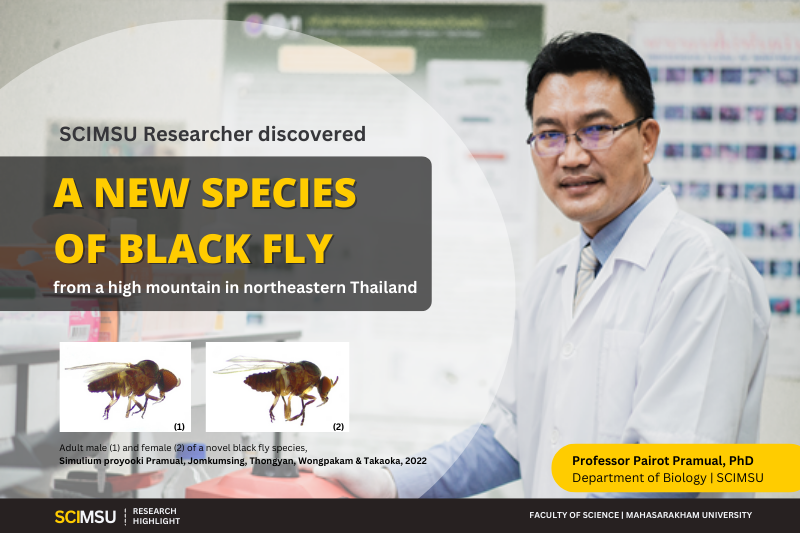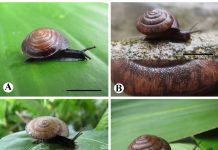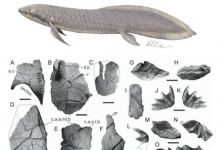Assistant Professor Dr Piyatida Pimvichai, a SCIMSU researcher from the Department of Biology at Mahasarakham University, and her colleagues published an article in ZooKey (2022). The publication entitled “Two new millipede species of the genus Coxobolellus Pimvichai, Enghoff, Panha & Backeljau, 2020 (Diplopoda, Spirobolida, Pseudospirobolellidae).”
Abstract: Two new millipede species of the genus Coxobolellus Pimvichai, Enghoff, Panha & Backeljau, 2020 from Thailand are described: Coxobolellus saratani sp. nov. from Loei Province and Coxobolellus serratoligulatus sp. nov. from Uttaradit Province. The descriptions are based on gonopod morphology and two mito-chondrial gene fragments (COI and 16S rRNA). The phylogenetic mtDNA analysis assigned the two new species unequivocally to the consistently well-supported Coxobolellus clade, in which they form a fifth subclade that was well supported by maximum likelihood analysis of 16S rRNA, though neither by Bayesian inference nor by COI. The two new Coxobolellus species share four conspicuous gonopodal synapomorphies of the genus: (1) the protruding process on the coxae of the 3rd (and sometimes 4th) pair of male legs, (2) a large, triangular coxae on the 4th–5th pair of legs, (3) a short process of the preanal ring protruding as far as, or slightly beyond, the anal valves, and (4) the posterior gonopod telopodite divided into two parts, with a conspicuous pore opening at the mesal margin at the end of the coxal part of the posterior gonopod. Thus, the two new species provide further evidence of the well-defined monophyly of the genus Coxobolellus. Finally, the paper provides an updated morphological identification key to all currently described Coxobolellus species.
Genus Coxobolellus Pimvichai, Enghoff, Panha & Backeljau, 2020
Diagnosis: Differing from the other genera of Pseudospirobolellidae by having (1) the coxae of the 3rd pair of male legs with extremely large, protruding processes (in C. albiceps and C. transversalis, this condition also applies to the 4th pair of male legs), (2) the 4th and 5th leg-pairs with large, triangular coxae, (3) short process of preanal ring protruding as far as, or slightly beyond, anal valves, and (4) the posterior gonopod telopodite divided into a coxal part (pcx) and a telopodital part (pt); with opening of efferent groove (oeg) at mesal margin at the end of coxal part (pcx).
Species description: The two new species share all of the diagnostic characters of the genus Coxobolellus, as described in the general description section in Pimvichai et al. (2020: 599–601).
Coxobolellus saratani sp. nov.
https://zoobank.org/NomenclaturalActs/C8EB9916-1AFE-465E-A630-12970577E4E5
Material studied: Holotype♂ (CUMZ-D00153-1), Thailand, Loei Province, Muang District, Phu Pha Lom; 17°32’30″N, 101°51’38″E; 370 m a.s.l.; 25 September 2021; P. Pimvichai, P. Prasankok and S. Saratan leg. Paratypes: 7 ♂♂, 9 ♀♀; same data as holotype (CUMZ-D00153-2).
Etymology: The species is named after Mr Sathit Saratan, who always supports the authors during fieldwork and who is a devoted millipede collector.
Description: Adult males with 51–55 podous rings. Length ca 6–7 cm, diameter ca 4.9–5.2 mm. Adult females with 52 or 53 podous rings. Length ca 6–8 cm, diameter ca 5.6–6.1 mm.
Colour: Living animal greenish grey except for dark brown antennae and legs.
Habitat: Found under leaf litter and crawling around (on the rock and stairs).
Distribution: Known only from the type locality in Loei Province, Thailand
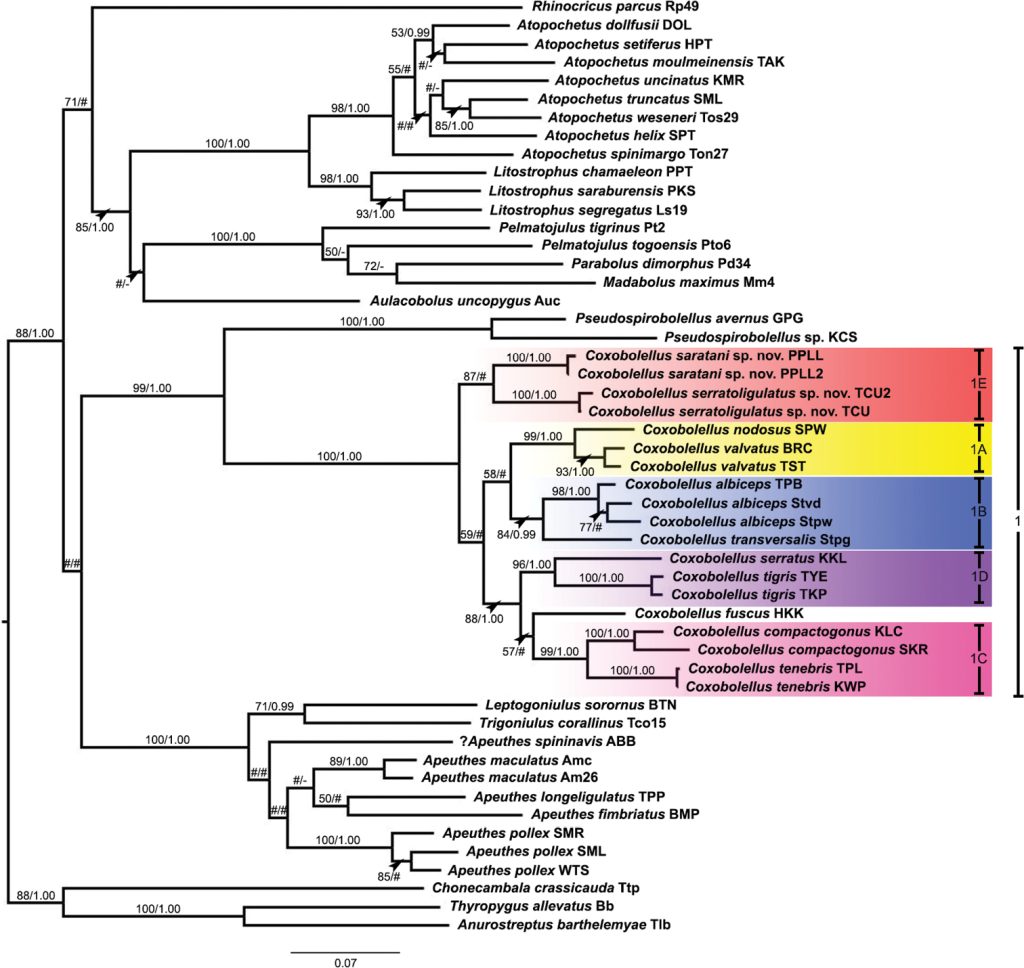
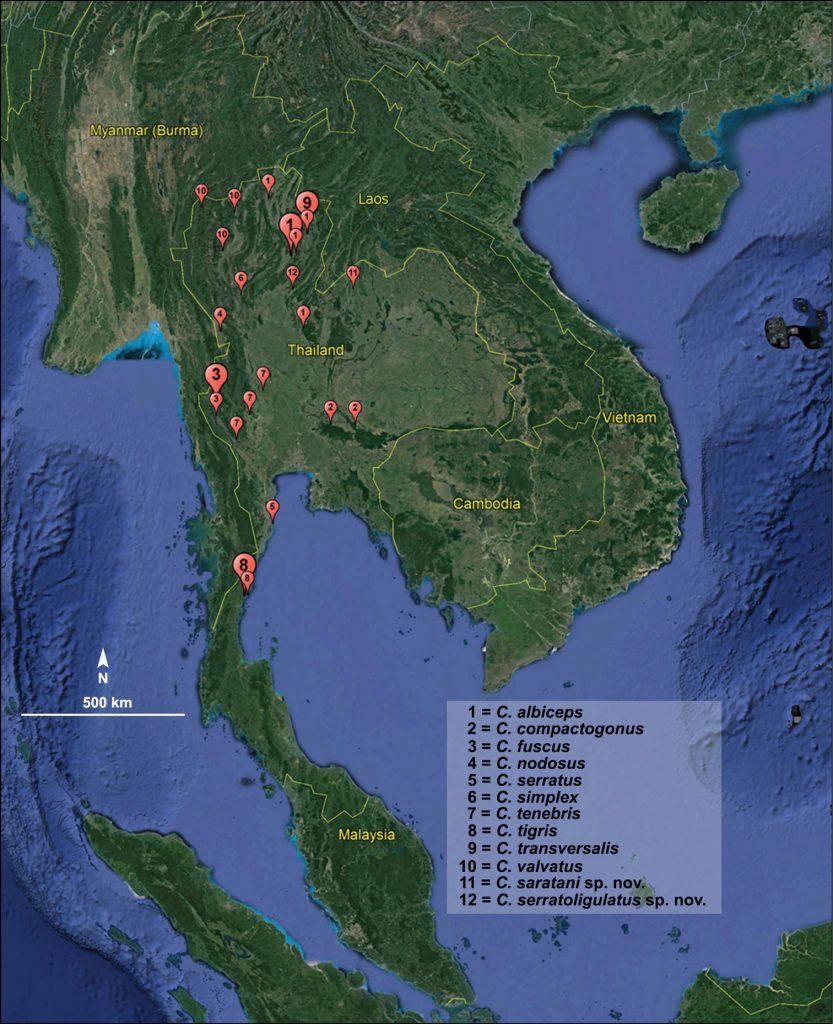
Coxobolellus serratoligulatus sp. nov.
https://zoobank.org/NomenclaturalActs/BDE726D9-4EC8-44F8-93D2-AE742C88A793
Material studied: Holotype♂ (CUMZ-D00154-1), Thailand, Uttaradit Province, Thong Saen Khan District, Tham Chan; 17°35’4″N, 100°25’10″E; 230 m a.s.l.; 31 July 2020; P. Pimvichai, P. Prasankok and S. Saratan leg. Paratypes. 2 ♀♀; same data as holotype (CUMZ-D00154-2).
Etymology: The species epithet is a Latin adjective meaning “with a serrated tongue” and refers to the characteristic process of the posterior gonopod.
Description: Adult male with 54 podous rings. Length ca 5 cm, diameter ca 4.0 mm. Adult females with 51–53 podous rings. Length ca 5 cm, diameter ca 3.9–4.1 mm.
Colour: Living animal dark green except for dark brown antennae and legs.
Habitat: Found under leaf litter.
Distribution: Known only from the type locality in Uttaradit Province, Thailand.
Pimvichai P, Enghoff H, Backeljau T (2022) Two new millipede species of the genus Coxobolellus Pimvichai, Enghoff, Panha & Backeljau, 2020 (Diplopoda, Spirobolida, Pseudospirobolellidae). ZooKeys 1128: 171–190. https://doi.org/10.3897/zookeys.1128.94242



